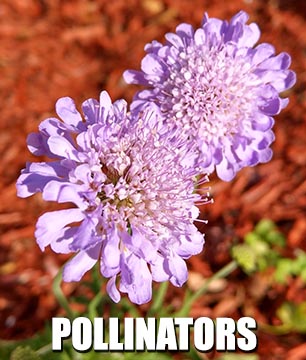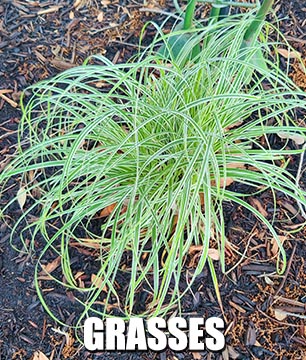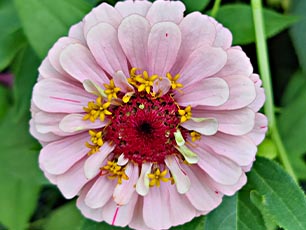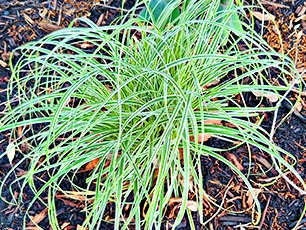What Grows in
North Texas
We are located in Zone 8a. Unfortunately, not all plants grow here in our
Texas climate. Don't worry. I've done the homework for you. Whether you want a plant that comes back every year, a pop of color, fruit trees, grasses, or even metal art, I can help you. Find out more on the nine slides below.

Texas Perennials
Plants that come back every year.Want to buy a plant that comes back every year? Read this article to learn more of what to plant for our Texas weather, our lack of water, and enjoy some color in the meantime.

Texas Annuals
Plants that live for one year onlyWant some quick color in your flower beds or garden? Need a plant to fill in some space? Annuals are great quick-growing flwowers that thrive in both sun and shade environments.

Texas Vegetables
Nutritious food for your familyTexas' hot summer and cool fall weather make it a great way to get two seasons of vegetables from your garden to your dinner table. Take advantage of this now!

Raised Bed Gardening
Explore this technique for successHow do you combat Texas' Houston Black Clay soil type? Find out the various ways to maximize your potential flower or edible gardens with raised beds.

Pollinators
Attract pollinators to your gardenDo you want to learn how to recruit the good bugs to fight the bad bugs? Yes. You can buy them, but it's way more fun to let them win the battle themselves!

Grasses & Turfs
Ornamental & functional grassesDo you want the best lawn in the neighborhood? Are you looking for colorful grasses to accent your flowers? Are you tired of watering your grass?

Fungi & Bacteria
What the heck is that in my garden?Over the years, I have seen some very interesting life forms grown in front of me. Find out what grows here locally in your neck of the woods.

Vines
What grows on my trellis?Vines are a great way to cover large areas of vertical spaces. Low on horizontal space and want to grow vertical? Find out what grows here.

Yard Art
Make your yard pop with art!What's the best way to have fun in your yard? Add art and colorful objects to compliment nature! I can give you some ideas and point you in the right direction.
Recent
Work
I love seeing before and after photos and the overall process,
so take a look at what I can do for you.
Looks Great! I'm in. How much does this cost?
Don't you get frustrated when you look for pricing and the website makes you fill out forms? Don't worry. I'll give you sample prices below.
PLEASE NOTE: Pricing in today's market is extremely fickle and prices for lumber and building supplies change daily. The raised bed prices below are temporary price, but it will give you an idea of what to expect and to plan for when using our services. We are also very upfront and honest with pricing, so feel free to ask any questions on billing and invoicing.
WOODEN RAISED BEDS:
4'L x 4'W x 20"H Pressure Treated Raised Bed Garden / Flower Bed (4x4 lumber) - $200
4'L x 4'W x 20"H Cedar Raised Bed Garden / Flower Bed (4x4 lumber) - $500
4'L x 4'W x 24"H Pressure Treated Raised Bed Garden / Flower Bed (2x8 lumber) - $150
4'L x 4'W x 24"H Cedar Raised Bed Garden / Flower Bed (2x8 lumber) - $300
OTHER MATERIALS:
4'L x 2'W x 2'H Galvanized Metal Raised Bed Garden / Flower Bed - $150
Custom materials raised beds (stone, fallen trees, etc.) - Price TBD - Let's chat!
Custom dimension Raised Bed Garden / Flower Bed - Let's talk on the phone or in person
ADD-ONS:
Examples: Custom paint color(s), landscape fabric, soil and mulches, fertilizers, mycology, etc.
My clear & transparent philosphy on billing:
We charge you for the labor and knowledge. We won't price gauge my customers on materials. If you supply the materials, then you pay for labor and knowledge. If we supply the materials, then we buy the materials and charge you for materials the time spent on obtaining the materials (time & gas - think around 20%). We will always find the best quality materials and pricing and we will be transparent about the entire process. Wehave connections that allow me to purchase materials and plants cheaper than the average consumer. We pass those saving along to our customers.
If at any point our customers feel as though they need to review any part of the process, there is always an open line of communication. We want to keep our customers happy so that they tell their friends and family. It is the way business should be.
Charles Does Gardens
Recommendations
Are you ready to start a garden? Want to plant flowers? See below for all of our services.
We have a form we can send you to get an idea of your ideal garden and flower bed.
I also can conduct a site visit to see your space. Just let us know!
-

Perennials
Plants that come back year to yearPerennial plants come back every year. While the initial investment is usually higher, the overall outcome means that you save money year-to-year. In addition to saving money on plants, you won't need as much fertilizer and pesticides. Perennial plants also have loads of color and benefits for the local landscape. I recommend you read and buy the plants according to color, dimensions, and purpose.
So how much of a price difference are we talking about between annuals and perennials? First, seeds are roughly the same price for perennials vs. annuals. However, when it comes to live plants, a Globe Amaranth (annual) may cost you around $8 each year while a Butterfly Bush (perennial) might cost you around $30. By planting a perennial, you will save time each year by not planting again and the plant will pay for itself. The cost of plants (and every year after) should always be factored into the overall project and budget.
You will also benefit from buying native plants by using less fertilizer and pesticides. Adpated and native plants, such as the Texas Superstar Plants, will be a solid choice when planning your garden here in North Texas. Not only do they grow in our soil, but they can survive our heat, extract the nutrients they require from our clay soils, and are less prone to insects and disease. Be sure to check the above link to see examples of these research-based proven examples of plants. It is a great resource for gardeners, ranging from beginners to professionals.
The trick to having a perennial plant come back to year to year is simple: find a plant that grows well and adapts to our harsh climate here in North Texas. Think of driving down a country road or Texas highway and looking out your car window to see vasts amount of Texas wildflowers and their natural beauty. These are perennials and don't have to be planted every year because Mother Nature does the work for you!
Charles' favorites: Fall Aster, 'Henry Duelberg' and 'Greggii' Salvias, Garden Phlox, Lantana, Black Eyed-Susan, Dwarf Mexican Petunia, Red Hot Poker, Daylily
-

Annuals
Plants that live for one year onlyLike the name suggests, annuals do not survive our Texas winters and will need to be planted every year. Annuals grow quickly in your gardens and flower beds and offer a great deal amount of color to fill between other plants. When selecting annuals for your location, it is important to consider two things: sun vs. shade.
What do you mean when you say 'sun vs. shade?' By definition, you can plant any play that is asun-loving plant when it receives 6-8 hours of direct sunlight. Keep in mind, that the Texas summers are brutal and in my experience, 6 hours is plenty of sun for most annauls. If your annual is listed as a shade-loving plant or a part shade to sun plant, find a location in your landscape that gets about 3 hours of sunlight in the morning or evening and is shaded during the hottest parts of the day.
As mentioned in my post about perennials vs. annuals, annuals tend to be cheaper in price. You can buy 'flats' of annuals for relatively cheap and sprinkle them all over your flower beds and gardens. I like to randomly add color in my landscapes. A garden or flower bed should be functional, but that doesn't mean it can't look visually appealing, too!
I have planted many different types of annuals over the years, but I now tend to stick with adpated and native plants, such as the Texas Superstar Plants. These plants were carefully selected and tested in our Texas landscapes to 'weed' out the weak plants and find plants that will grow easily.
Last, when it comes to colors and making your garden 'pop,' I recommend a mixture of perennials, annuals, and grasses. (Don't forget a piece of yard art or sculpture! They can also survive our Texas weather.)
The trick to selecting annuals is simple. I start with a color I want. From that point, I research how big the plant will grow. Last, once I have color and dimension in my mind, I find a great sunny or shady location and pick my plant. Once again, try to find a plant that grows well and adapts to our harsh climate here in North Texas.
Charles' favorites: Texas Bluebonnets, Celosia, Blue Daze, Marigold, Petunia, Pentas, and Zinnias
-

Vegetables
Nutritious and delicious food you and your familyMost people we know started to think about growing their own source of food and gardens during the year 2020. We all remember that year was filled with panic, uncertainty, and confusion. Now is the best time to grow your own and get your hands into the ground!
What vegetables, fruit and herbs grow here in North Texas? Well, the short answer is: (almost) all of them!
When it comes to growing your own plants from seeds, you have to remember this: W-O-L-T (Water - Oxygen - Light - Temperature). In order for seeds to germinate and sprout, they must have enough water/moisture, they must have access to enough oxygen, they do need some light, and they also must be in the correct temperature zone. If you have these four characteristics, then you will succeed. I have purchased so many exotic seeds and plants over the years. Some survived... most of them did not grow. A really good resource for everyone in Texas would be the Texas A&M Agrilife extension. Particularly for vegetables, their website has a whole list of varieties that grow well in your region. The website is Texas Vegetable Variety Selector.
The trick to growing vegetables is intuitive. I start with what I actually eat. This may sound kind of simple. I have grown vegetables because they looked cool, but I didn't like the taste or they were very finicky. Don't waste your money and time!
Also, my best piece of advice is to start small and work your way up to a larger garden. For example, when I plant and harvest spaghetti squash, I might have 20+ squash ready to p[ick at one time. What am I going to do with 20 squash? I can't eat ALL of them at once.
Charles' favorites: Any cherry tomato variety, Spaghetti Squash, Beets, Onions, Spinach, Green beans, Garlic, Basil, Dill, Oregano, Cucumbers
-

Raised Beds
Techniques & Plans for Raised Beds GardensWait!!! People have been growing plants and food for centuries in the soil. Why a raised bed? The answer is simple for residents of Collin County: Houston Black Clay. This type of soil is very fertile, but the soil can only absorb around 1/10" of liquid per hour. Because the soil can't absorb moisture very quickly, it is very easy to overwater and drown plants. There are two ways to fix this:
1) We can add amendments, such as expanded shale (can be expensive), compost and mulch.
2) We can buy already mixed soils that contain expanded shale, perlite, compost and mulch.
Either way, in order to grow strong, healthy, and productive plants, you need to start with good soil. Once we have good soil, the fun begins and we can start planting. The next step is to figure out how deep the roots of your plants will dig. When you figure that out, you can start the construction on your raised beds. We recommend that the beds are 12" to 24" (or more if your budget allows). Most roots we be from 8" to 12". We highly recommend raised beds for everyone because it is an easy task to accomplish, it raises the heights of the plants so you don't have to bend over, and it makes weeding easier. Watering and harvesting your plants will also be much easier.
When it comes to materials for your raised beds, you can use anything you want. You can use an old wheelbarrow, landscape timbers, pine, cedar, metal troughs for horses, etc. It is up to you and your budget. Ask us for photos of these different types of materials. We would be happy to show you.
SPECIAL TOPIC:
One topic I get asked and I want to include is the use of pressure treated wood in your raised bed garden. You may have heard that the chemicals used in treated lumber can cause all type of health problems. Those stories are from before 2003 when pressure treated lumber was treated with CCA (chromated copper arsenate) or ACA (ammoniacal copper arsenate). After 2003, all pressure treated lumber is treated with alkaline copper quaternary (ACQ). Studies have shown that the chemicals do not leach into the surrounding soils. We reference the study here from Iowa State University. If you are worried about this, then we will be happy to use other types of materials.
Charles' favorites: 4"x4" cedar posts, pressure treated wood (ACQ), bricks, and metal horse troughs
-

Pollinators
Attract pollinators to your gardenSo you've planted your flowers, trees, and vegetables. Now what? You need to attract the good bugs to pollinate your plants (and fight off the bad bugs - more on that later). There lots of different pollinators ready to work and some you might not even think. For example, we all know about butterflies and bees, but did you know that bats, bees, hummingbirds, moths, wasps, flies, and beetles also play an important role in pollination here in Collin County?
In order to attract these important pollinators, you will need three things:
1) Food - the nectar from your pollinator plants
2) Water - any water source (not a pool)
3) Shelter - trees, shrubs, grasses, leaves, rotting wood, etc.
Another good beneficial aspect of attracting pollinators are that they also provide some integrated pest management (IPM). For example, I once saw a wasp hovering around my kale plants. It disappeared and then flew out from under a leaf with a nice, juicy caterpillar in its mouth. No one likes wasps, but they also serve another purpose besides pollination.
Last, a big key step to attracting pollinators is using less pesticides and insecticides. Chemicals do not distinguish from good bugs and bad bugs and they are created to kill and they work! You can also use compost to fertilize your plants instead of commercial fertilizers.
Charles' favorites: plant dill to attract parasitoid wasps and flies, plant basil for bees, plant zinnias for flowers and attracting butterflies and bees, plant alyssum for their sweet smell and to provide shelter for ground-dwelling beneficial insects, plant yucca to attract hummingbirds, plant Gregg's Mistflower and Texas Lantana with Butterflyweed for the trilogy to attract Monarch butterflies
-

Grasses
Ornamental and Functional GrassesWe will talk about ornamental grasses here and not lawns. Ornamental grasses serve a few purposes.
First, grasses native to the Texas landscape provide movement in your garden. Picture a field of grass with wind blowing the leaves back and forth. You want your garden to move and flow in the wind and make it seem alive.
Second, grasses can provide color and texture. We think of grass as being green, but grasses come in a few additional colors like, blue, purple, and grays. You can even find striped grasses like zebragrass.
We like to plant grasses to fill in space around your flowerbeds and to add height to your beds. Some grasses will spread over time and become groundcover and some grasses will stay put where you put them. Once again, a mixture of plants, flowers, and grasses will be your best bet for your landscape.
Charles' favorites: Gulf Muhly for it's pink/purple leaves, carex to fill in spaces in your flowerbeds, and the Texas tough Lindheimer Muhly
-

Fungi
What fungi looks like in your gardenWhere to begin with these odd looking organisms? Well, let's start by describing exactly what it is. Fungi are large groups of organisms that include molds, mushrooms, and yeasts. Most fungi feed on decaying matter and help break down matter to put nutrients back into soil. They are essential to plant growth and development. Scientists have identified more than 70,000 species of fungi. Only about 1% of fungi cause diseases in plants, so odds are in your favor that your fungi or slime mold is not harmful.
My advice to anyone seeing fungi and slime molds in their gardens is to either admire it or remove it. The fungi in your garden is more than likely breaking down decyaing mulch and making the nutrients available to your plants. This is a good thing! It means that your soil is alive and the tiny ecosystem in your yard is working.
In my yard, I usually encounter slime molds and fungi in the spring. The three most prevalent in my yard are Hydnellum peckii (Bleeding Tooth Fungus), Phallus impudicus (Common Stinkhorn) and Fuligo septica (Dog Vomit Slime Mold). [Side note: don't you just love the names!] All three are harmless. When I walk in my backyard, I can atucally smell the stinkhorn before seeing it. It's a wierd smell and takes somegetting used to. When I see it, it is usually covered in flies (which help spread its spores). If you have a wood pile, you more than likely have Trametes Versicolor (Turkey Tail). Turkey Tail is actually used in modern medicines to boost your immune system and even help fight certain cancers. That being said, please do not eat any fungus without consulting someone who knows exactly the exact species of fungi.
Charles' favorites: Common Stinkhorn, Turkey Tail, Bleeding Tooth fungus, Barometer Earthstar, Lysurus
-

Vines
Grow Tall and wide on structuresThe best way to add height/width to your landscape is to grow vines. Vines are some of my favorite because they usually offer lots of colorful blooms and add will pique your interest. Do you have a wall that is boring and want to add some plants that will cling onto the bricks or wood? Do you want to create a barrier with plants? Do you want to add some dimension to your flower beds? You can do all of this with vines!
When it comes to vines, there are many options here in North Texas. You can go with traditional vines such as Lonicera Sempervirens (Coral Honeysuckle) or Parthenocissus quinquefolia (Virginia Creeper) or you can go more exotic and grow Passiflora incarnata (Passionflower) or Rosa setigera (Climbing Prairie Rose). Which ever way you choose to go, just be aware that some vines grow underground and spread very quickly to other parts of your yard. For example, I planted a Passion Flower vine in my garden along the fence and now it is growing 20 feet away in my raised bed. I now have to pull it like a weed!
My favorite vine is the Passion Flower (passiflora incarnata). I love the beautiful and alien-like flowers it brings to the table. Also, the gulf fruitillary butterfly lays its eggs on the leaves and I get another pollinator to add to my growing list of friendly pollinators. The passion flower vine comes back every year. When the ground freezes, i simply cut it to the ground and next year, I will have more vines spring up. The Passionflower also thrives in our Texas heat. I have plenty of cuttings to give to friends and family every year as well. It is an easy plant to grow and requires little to no maintenance.
Charles' favorites: Passionflower (purple flowers), Coral Honeysuckle (red, tubular blooms), Climbing Prairie Rose (pink flowers), Carolina Jessamine (yellow flowers)
-

Yard Art
Add a funky side to your gardenThis is the really fun part! Adding color and fun visuals to your garden and flower beds. My wife and I love going to small, local nurseries, garage slaes, estate sales and swap meets to find uncommon pieces of art to put in our yard. Luckily, we have no HOA and it allows us to be really creative.
Where can you find yard art? Your local nursery is a good start. Do your neighbors have a piece of yard art that you like? Knock on their door and ask where they purchased it. Go to your local art show and look for yard art vendors that have 'kinetic scupltures' or outdoor scupltures. Last, check your local antique shop or resale shop. My wife found a stainless steel bottom of a glass table (with no glass) for under $20.00 at a resale shop. It looks cool in our front flower bed.
When it comes to art, make sure it will stand the test of time (you can clear coat any metal to prevent rust) and also make sure there are no restrictions with your Home Owners Association. You don't want to spend a few hundred dollars on something you are not allowed to display.
Charles' favorites: Kinetic Metal Art (moves with the wind), pieces of found art at a resale shop, visiting your local swap meet to find cheap metal art, finding boring metal art and spraypainting it bright colors, creating gnome gardens
Contact
CharlesDoesGardens
Charles is a gardener and lover of plants in Collin County, TX.
If you want to start a project or ask a question, please use the form below or call him at 214-494-1912.




